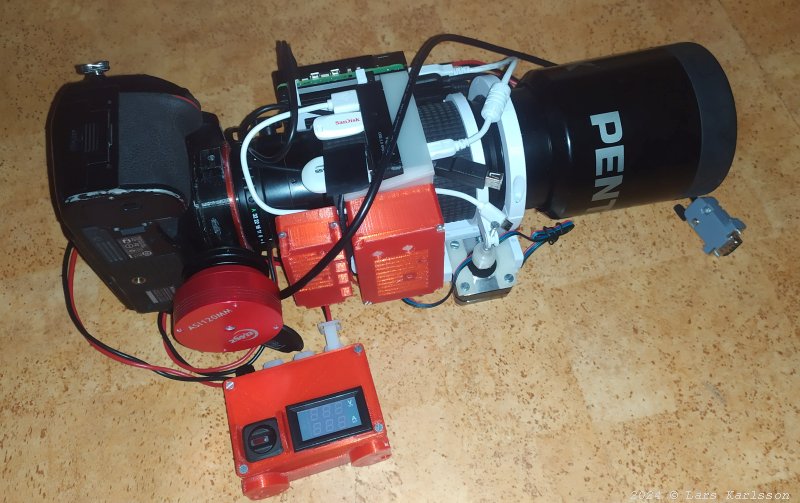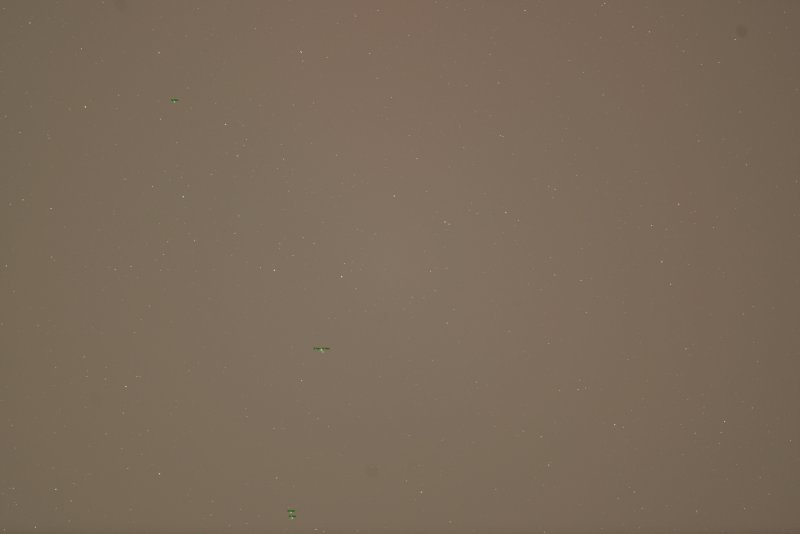9: First Light
It's always exiting when testing some new equipment.
In this case both the Nikon D800 and the Pentax 645 FA 300mm f/4 lens are new to me (but used).
Latest look of the equipment:

I had to do a quick fix, in an earlier test I couldn't reach focus at infinity.
The distance between the camera sensor to lens was too long. I designed a new adapter the was 2.37 mm shorter.
That was the shortest I could make it and still have space for the off-axis system.
After that I can focus correct and have some head room to let the auto focuser work correct.
Even the control software is new, KStars 64-bit version.
The driver for the mount, EQMOD isn't finished yet to handle custom gear ratio, but I can use some parts of the software I changed from the earlier 32-bit version.
The guide camera isn't running yet either.
So I'm just let the telescope point somewhere out their in the dark space and took a series of photos.
Pointing to coordinates RA 4h 57 DEC 61o 07m:
 (Click on the image and get a high resolution one in a new window)
(Click on the image and get a high resolution one in a new window)
I didn't knew where the telescope is pointing, but later when the photo was plate solved I got to know.
Pointing to coordinates RA 4h 57 DEC 61o 07m.
A boring place, no exiting objects but stars, from the stars I can judge the quality of the system.
The camera was setup to: 60 seconds, 400iso and I got 28 of them.
Without the focus motor it's not easy to get correct focus.
The mount RA speed is wrong so it elongate the stars.
But other than that it looks promising.
 (Click on the image and get a high resolution one in a new window)
(Click on the image and get a high resolution one in a new window)
Sky chart's view of the area I took the photo from.
Plate solved sub image:
 (Click on the image and get a high resolution one in a new window)
(Click on the image and get a high resolution one in a new window)
When I analyzing the Nikon NEF raw format files I got some surprises. First, they don't have any bias !
That can cause some problems when processing them.
In darker areas of a photo the signal can be very low, together with the noise it can generate a negative sign, but in this case the Nikon clip the negative values.
Maybe one reason that few people use this camera or other Nikon.
But in reality the signal is much higher because of the light pollution so I don't think it will cause any problem for me.
One positive thing from this is that I get more digital room.
14-bit as the DSLR cameras normally has give 16'000 digital units, but with a bias as Canon use of 2048 ADU there is only 14'000 digital units left.
With this Nikon camera I get a little bit more head room.
One of the other thing is that the Nikon with its Sony sensors are ISO invariant, same readout noise for all ISO settings.
The Canon has a pre amplifier that raise the signal before it's converted by the ADC to a digital signal.
One reason why Canon normally are setup to ISO 1600 or there about, but it limit the head room for the signal, it clips the higher level.
With the Nikon I will test to use lower ISO, 400 or so.
The signal will not clip that early and I can expose longer, get more photons to the sensor.
Other things, the Sony sensors normally have less banding problem compare to the Canon sensors.
The Nikon camera is more pixel density, 4.88 my vs Canons 6.54 my.
Give me a more preferable pixel scale.
One thing I noted when I used the Nikon camera, the shutter sounds like a hammer out there in the dark.
Maybe the camera can be setup to work a little bit more gently.
Later I found it can be set to Q-mode, it helps a little.
|